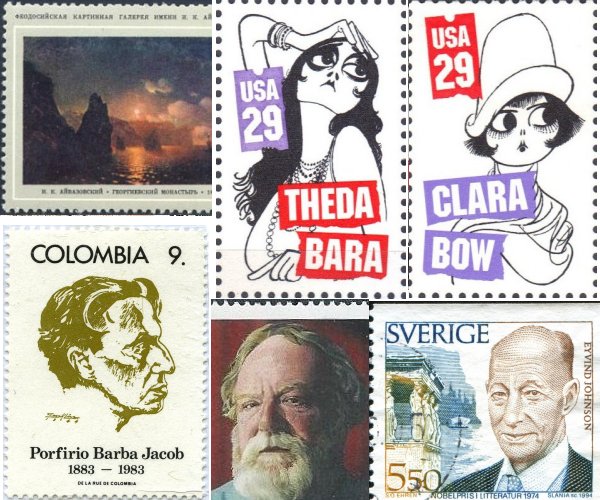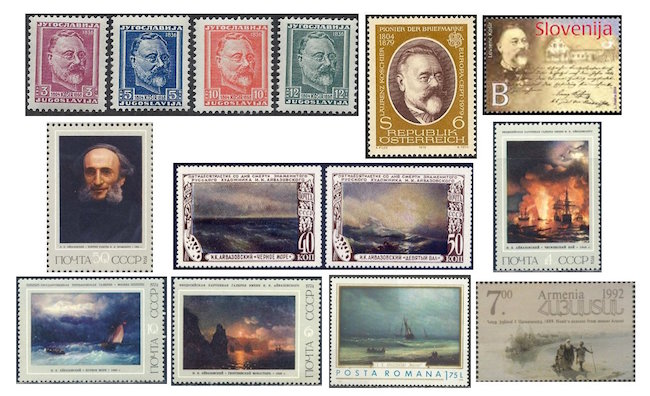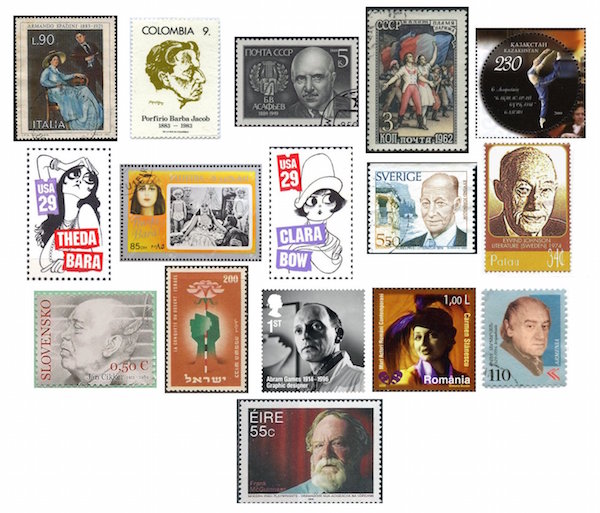The Arts on Stamps of the World — July 29
An Arts Fuse regular feature: the arts on stamps of the world.

By Doug Briscoe
Today we begin with a nod to the Slovenian Laurenz Koschier (or Lovrenc Košir, 29 July 1804 – 7 August 1879), an official in the Austro-Hungarian service who proposed the creation of postage stamps in 1835. For this reason he is cited by Austria, Yugoslavia, and Slovenia (and honored on their stamps, q.v.) as the inventor of the postage stamp. But not so fast. Some give the credit to the Scotsman James Chalmers, who is thought to have come up with the idea in 1834, though he didn’t submit it until 1838, by which time he had also come up with a prototype for a cancelling device. As far as the consensus goes, however, and because his version was the first to be put into practice (in 1840), the Briton Sir Rowland Hill is seen by most people who care about such things as the inventor of the postage stamp. Koschier’s idea was rejected by the bureaucrats, and Austria didn’t join the postage stamp bandwagon until 1850, behind the Swiss canton of Zurich, Brazil (both 1843), the United States (1847), and France (1849). Koschier’s quaint designation for the new item was “gepresste Papieroblate” (“pressed paper wafers”). We English-speaking types call them stamps because the first postmarks—dating from 1661!—were applied with a cork handstamp.
Our first true artist today is Russian seascape painter Ivan Aivazovsky (29 July 1817 – 2 May 1900), much remembered on stamps of the Soviet Union, as well as on a couple from Romania and Armenia. Aivazovsky, actually, was an Armenian, born Hovhannes Aivazian in the Crimea. He studied at the St Petersburg Academy, where he met Pushkin, and was sent for further study in Germany, France, Italy, where he met Gogol and yesterday’s birthday boy Alexander Ivanov, and England, where he met JMW Turner. All along the way he garnered more gold medals for his work, and Turner was so impressed with one of Aivazovsky’s paintings—The Bay of Naples (1841)—that he wrote a rhyming eulogy to him in Italian. On arriving back in Russia he was named official artist of the Russian Navy and, though he continued to travel extensively and often, settled in his native Crimea and went on collecting honors. Anton Chekhov used a phrase, “worthy of Aivazovsky’s brush,” to describe something of great beauty. He was the first Russian and the first non-French artist to receive the Légion d’honneur. An exhibition he held in London in 1881 was attended by Millais and the Prince of Wales, and in 1892 he visited the United States for the Columbian tricentenary. So now to the pictures. Before seeing Aivazovsky’s own work, I thought I’d lead off with a portrait of him by Ivan Kramskoi. Another one by Alexey Vasilievich Tyranov, whose birthday is next week, I’ll reserve for that occasion. It was among the first stamps to be produced in the artist’s honor, from 1950, which included also Black Sea and Ninth Surge. Next to that pair is The Battle of Chesma (1848) and, in the next row, three more seascapes—the middle one depicts St. George’s Monastery, Cape Fiolent (on the northern coast of the Black Sea) from 1846—and, at the end, for a change of pace, one of Aivazovsky’s religious works, Descent of Noah from Mount Ararat (1889). There is also an abundance of the colorful international souvenir sheets I turn to so often here, but they prove unnecessary given the otherwise plentiful supply.

Our next two figures were born on precisely the same day, July 29, 1883. Italian painter Armando Spadini was born in Florence and began his artistic career in ceramics. He relocated to Rome in 1910 and painted scenes of the city, genre pictures, and portraits like Artist and Model, seen on the 1975 Italian stamp. He died in the capital on the 31st of March (or May, I don’t know who’s right) in 1925.
Colombian poet Miguel Ángel Osorio Benítez used multiple pseudonyms, but the one by which he is best remembered is Porfirio Barba-Jacob. He traveled much through the Americas, not always by choice, founding a literary magazine in Bogotá in 1902 and writing his first poems back in Colombia in 1907. It is from this period that his best known poem, “Canción de la vida profunda” (“Song of the deep life”) dates. His friendship with Mexican President Porfirio Díaz led to his fleeing that country for Guatemala after Díaz’s ouster, then to Cuba after a contretemps with Guatemalan President Manuel Estrada, then back to Mexico in 1918. Thereafter history repeated itself to some extent, as Barba-Jacob was again hounded out of Mexico to Guatemala and out of Guatemala to…El Salvador, this time. There, too, he was labeled “immoral” and “subversive”, and it was back to Mexico yet again. He ended his days there on January 14, 1942.
Russian composer, musicologist, and critic Boris Asafyev (a-SAHF-yeff) was born on this date (O.S. July 17) in 1884. Among his works are 26 ballets, nine operas, five symphonies, three concertos (one each for clarinet, guitar, and piano), and chamber music. His writings, appearing under the pseudonym Igor Glebov, include books on Stravinsky and Glinka. Prokofiev‘s famous “Classical” Symphony is dedicated to Asafyev. He died on Mozart’s birthday, January 27, 1949. The portrait stamp was issued for his centenary in 1984, but his work had already been recognized philatelically on one of a group of four stamps honoring the Russian Ballet issued in 1961 and 1962. It depicts a scene from his Flames of Paris (1932), a ballet set during the French Revolution. In 2009 Kazakhstan produced a lovely souvenir sheet of six stamps celebrating Kazakh theater, one of which represents Asafyev’s ballet The Fountain of Bakhchisarai (bahkh-tchee-sa-RYE) of 1936.

Two American actresses of the silent screen era share this July 29 birthday, and both were included in a 1994 block of stamps in caricatures by Al Hirschfeld. Both “The Vamp” and “The It Girl” were beauties, sex symbols, and box-office gold. The elder of the pair by twenty years was Theda Bara, born Theodosia Burr Goodman in 1885. She came from Cincinnati, the child of a Jewish father from Poland and a Swiss mother. She made her debut on Broadway in 1908. Most of her forty or so films were made before 1920, and sadly, almost all of them were lost in the Fox vault fire of 1937. She made only three movies in the twenties, two of them shorts, and never appeared in a talkie, having retired in 1926. Though she hoped to break free of her femme fatale image, she was usually typecast as “The Vamp”. Theda Bara died on April 7, 1955. Clara Bow (July 29, 1905 – September 27, 1965) grew up poor in Brooklyn and won an acting contest that got her a role in a 1921 film when she was just sixteen. Bow was brokenhearted when she thought, apparently erroneously, that she had ended up on the cutting room floor. She was a hit with the critics in her next film, and went on to appear in the first Oscar-winner, Wings, in 1927. She made almost fifty silents before the talkies came in, and she made eleven of those. Retiring in 1933 for a life of ranching with her husband, Clara Bow died of a heart attack at age 60. Max Fleischer’s cartoon character Betty Boop was based on her.
Swedish author Eyvind Johnson (29 July 1900 – 25 August 1976) was awarded the Nobel Prize in Literature, along with Harry Martinson, in 1974. As I related in connection with Martinson, there was some controversy over the selection of both men for the prize, given that both were on the awards panel, and other nominees that year were Graham Greene, Vladimir Nabokov, Saul Bellow, and Jorge Luis Borges. In any case, Johnson contributed articles to anarchist magazines before he was twenty and published his first book, a short story collection, in 1924. He was more renowned for his 28 novels, of which four, forming the tetralogy Romanen om Olof (The Novel about Olof, 1934-37), made Johnson’s first noteworthy success. Fiercely antifascist, he also wrote an allegorical trilogy, Krilon, about the first years of World War II and, just after war, a retelling of the Odysseus legend, Return to Ithaca (originally Strändernas svall, 1946).
Slovak composer Ján Cikker (1911 – 21 December 1989) studied at the Prague Conservatory under Vítězslav Novák and in Vienna with Felix Weingartner. He taught at Bratislava’s Conservatory and acted as repertory advisor of opera for the Slovak National Theatre until 1948, when the communist takeover of Czechoslovakia resulted in his being dismissed from the post. He went instead to the Bratislava Academy of Music and Dramatic Arts. Cikker’s early works were mostly instrumental; he turned to opera beginning in the 1950s. As I looked through a list of his compositions I found a number of titles that intrigued me. He wrote operas on Shakespeare’s Coriolanus, the Antigone of Sophocles, Mister Scrooge after Dickens, Tolstoy’s Resurrection (also made into an opera by Franco Alfano), as well as operas after Romain Rolland and the Čapek brothers. Besides several symphonic poems, including a cycle of them called “About life”, he also produced a Spring Symphony, a Slovak Suite, Meditations on a theme of Schütz, a Piano Concerto, two string quartets, etc.
Abram Games (29 July 1914 – 27 August 1996) was an important British graphic designer who created posters for sixty years, beginning in the mid-30s. Some of the more noteworthy of these were made for the war effort during World War II. His parents were Jewish emigrés from Latvia and the Polish-Russian borderland who changed their name from Gamse to Games when Abram was a child. He also did some industrial design and philatelic design, one example being his stamp for the Conquest of the Desert Exhibition held in Israel in 1953. I show that stamp as well as a much more recent British one honoring the man himself.
Romanian actress Carmen Stănescu (born 29 July 1925) turns 92 today. Her stage career began in 1945, and she appeared as recently as 2004 in a Romanian language version of an Anouilh play. In 2001 she gave a turn as Eleanor of Aquitaine in The Lion in Winter by James Goldman. Her work in film has been less extensive, with about ten roles in Romanian movies between 1958 and 1977.
Armenian composer Avet Terterian (stamp at bottom right) was born Alfred Terterian in 1929 in Baku. He studied there and in Yerevan. In the early 60s he was Executive Secretary of the Armenian Componers’ Union and later held other administrative and teaching posts. He was the composer of eight symphonies (a Ninth remained unfinished at his death), two operas, a ballet, chamber music including three string quartets, vocal pieces, and film music.
Irish writer Frank McGuinness (born 1953) is best known for his plays and poetry, but he has also worked in other genres, having published his first novel, Arimathea, just four years ago and his first opera libretto, Thebans, after Sophocles, with music by Julian Anderson, in 2014. McGuinness has also adapted many classic plays by Racine, Chekhov, Ibsen, Garcia Lorca, Strindberg, and others. His first full-length play was 1982’s The Factory Girls, which he followed with the multiple award-winning Observe the Sons of Ulster Marching towards the Somme (1985). His first poetry volume, Booterstown, dates from 1994.
A graduate of the University of Massachusetts with a B.A. in English, Doug Briscoe worked in Boston classical music radio, at WCRB, WGBH, and WBUR, for about 25 years, beginning in 1977. He has the curious distinction of having succeeded Robert J. Lurtsema twice, first as host of WGBH’s weekday morning classical music program in 1993, then as host of the weekend program when Robert J.’s health failed in 2000. Doug also wrote liner notes for several of the late Gunther Schuller’s GM Recordings releases as well as program notes for the Boston Classical Orchestra. For the past few years he’s been posting a Facebook “blog” of classical music on stamps of the world, which has now been expanded to encompass all the arts for The Arts Fuse.
